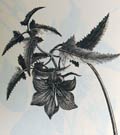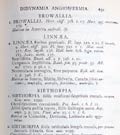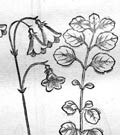Cabinet 14 - Towards Species Plantarum
 In 1735, Linnaeus was employed by George Clifford (1685-1760), an Anglo-Dutch banker, to describe all of the living and dried plant material at his summer estate of Hartekamp, south of Haarlem. Linnaeus's job entailed the supervision of the hothouses, visits to England and France to obtain plants, and the naming of specimens and classifying them according to his own system. Hortus Cliffortianus (1737) - the first such description of an English garden – took nine months to write. Georg Dionys Ehret and Jan Wandelaar supplied the illustrations. With the use of binominal names and many type specimens described, Hortus Cliffortianus was the precursor to Linnaeus's Species Plantarum (1753). The Campanula (bellflower) and Rauvolfia (the insanity herb) are on display.
In 1735, Linnaeus was employed by George Clifford (1685-1760), an Anglo-Dutch banker, to describe all of the living and dried plant material at his summer estate of Hartekamp, south of Haarlem. Linnaeus's job entailed the supervision of the hothouses, visits to England and France to obtain plants, and the naming of specimens and classifying them according to his own system. Hortus Cliffortianus (1737) - the first such description of an English garden – took nine months to write. Georg Dionys Ehret and Jan Wandelaar supplied the illustrations. With the use of binominal names and many type specimens described, Hortus Cliffortianus was the precursor to Linnaeus's Species Plantarum (1753). The Campanula (bellflower) and Rauvolfia (the insanity herb) are on display.
Carl Linnaeus, Hortus Cliffortianus. Amsterdam, 1737. Lehre [Germany]: J. Cramer; Codicote, [England]: Wheldon & Wesley ; New York, Stechert-Hafner Service Agency, 1968 (facsimile). Special QK 91 HT 52 1968
 The publication of Linnaeus's Species Plantarum in 1753 is regarded as the starting point for the Latin binomial, or two-word, names of plants. Before his taxonomic system was adopted, there was confusion. For example, the Wild Briar Rose was identified by botanists as Rosa sylvestris alba cum rubore, folio glabro (roughly meaning pinkish white woodland rose with hairless leaves), and Rosa sylvestris inodora seu canina (odorless woodland dog rose). The Linnaean system reduced the confusion by tagging it simply - Rosa canina. Some 5,900 different plant species were labeled in Linnaeus's Species Plantarum, a work which he himself called 'the greatest in botany.' One of note was Linnaea borealis, the hardy twinflower which became a floral talisman for Linnaeus.
The publication of Linnaeus's Species Plantarum in 1753 is regarded as the starting point for the Latin binomial, or two-word, names of plants. Before his taxonomic system was adopted, there was confusion. For example, the Wild Briar Rose was identified by botanists as Rosa sylvestris alba cum rubore, folio glabro (roughly meaning pinkish white woodland rose with hairless leaves), and Rosa sylvestris inodora seu canina (odorless woodland dog rose). The Linnaean system reduced the confusion by tagging it simply - Rosa canina. Some 5,900 different plant species were labeled in Linnaeus's Species Plantarum, a work which he himself called 'the greatest in botany.' One of note was Linnaea borealis, the hardy twinflower which became a floral talisman for Linnaeus.

